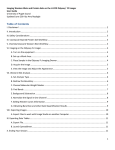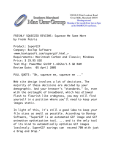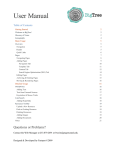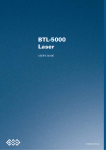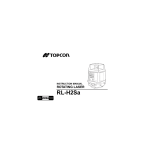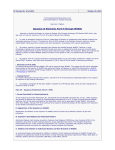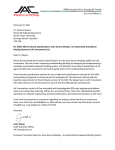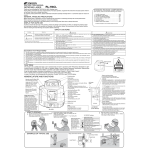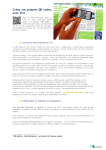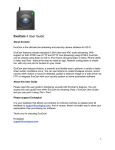Download Nucleic Acid Full User Guide
Transcript
Imaging Nucleic Acid Gels on the LI-COR Odyssey® FC Imager User Guide University of Puget Sound Updated June 2014 by Amy Replogle Table of Contents I. Disclaimer! ........................................................................................................................................................... 2 II. Introduction ........................................................................................................................................................ 2 III. Safety Considerations ........................................................................................................................................ 2 IV. DNA Separation on Agarose Gels ...................................................................................................................... 3 A. Suggested Materials .................................................................................................................................... 3 B. In-Gel Pre-Staining Protocol ........................................................................................................................ 3 V. Imaging on the Odyssey Fc Imager ..................................................................................................................... 4 A. Turn on the equipment ............................................................................................................................... 4 B. Set up a Work Area ...................................................................................................................................... 4 C. Place Sample in the Odyssey Fc Imaging Drawer ........................................................................................ 4 D. Acquire the Image ....................................................................................................................................... 5 E. View the Image and Adjust the Appearance ............................................................................................... 5 VI. DNA Gel Analysis................................................................................................................................................ 6 A. Set Analysis Type ......................................................................................................................................... 6 B. Redraw the Boundary .................................................................................................................................. 6 C. Choose Molecular Weight Marker .............................................................................................................. 7 D. Find Bands ................................................................................................................................................... 7 E. Background Subtraction .............................................................................................................................. 7 F. Editing DNA Gel Lane Information ............................................................................................................... 8 G. Obtaining Band Size and other Band Quantification Results ...................................................................... 8 VII. Exporting Images .............................................................................................................................................. 9 A. Export Files to work with Image Studio on another Computer .................................................................. 9 VIII. Exporting Data Tables .................................................................................................................................... 10 A. Export File .................................................................................................................................................. 10 B. Launch Spreadsheet .................................................................................................................................. 10 IX. Ending Your Session ......................................................................................................................................... 10 1 I. Disclaimer! Please note: this is an abbreviated guide. The actual manual for this imager + software package is spread over several volumes. While it is a good exercise for any student to read the user manual when beginning work on a new instrument, this User Guide can serve as a guide to general use of the instrument and may be sufficient for many uses. However, in the event that you encounter trouble, need more information, or require assistance, contact Amy Replogle: E-mail: [email protected] Office: 117H Thompson Hall Office Phone: 253-879-2829 Cell Phone: 253-973-1088 II. Introduction Students should always have training on the Odyssey Fc Imager prior to independent use! Contact Amy Replogle (see contact information above) to set up a training session. Although the Odyssey Fc Imager, with 600 nm channel capabilities, can image agarose gels stained with popular DNA stains, such as ethidium bromide and SYBR Safe DNA stain, with sub-nanogram sensitivity, please DO NOT use ethidium bromide with this imaging system. The Odyssey Fc Imager contains a 532 nm diffuse source with an excitation maximum of 520 nm and a detection maximum of 600 nm. SYBR Safe DNA stain (Ex/Em = 502/530 nm) has been tested on the Odyssey Fc Imager (using the 600 channel) with sensitivities exceeding ethidium bromide detection. The maximum fluorescence emission wavelength of SYBR Safe is very close to the maximum excitation wavelength. However, the Odyssey Fc 600 channel collects excitation light at a wavelength 50 nm higher than the maximum excitation wavelength of SYBR Safe. These instrument properties decrease the background and improve the signal-to-noise ratio for nucleic acid detection. III. Safety Considerations The Odyssey Fc Imager is certified as a Class I laser product. This means that hazardous laser radiation is not emitted outside the instrument. Radiation emitted inside the Odyssey Fc is confined within protective housings and external covers. A series of safety interlocks ensures that the laser beam cannot escape during any phase of user operation. One laser emits at 785nm and the other one at 685nm. The 785nm laser has a peak power rating of 1 watt. The 685nm laser has a peak power rating of 0.5 watt. The 685nm laser emits visible laser radiation- direct exposure to either beam may cause eye damage. Laser radiation from each laser uniformly illuminates the target area only, which is marked in the imaging tray that fits in the imaging drawer. There is no emission of laser radiation outside the instrument under normal conditions. WARNING: Use of controls or adjustments or performance of procedures other than those specified herein may result in hazardous radiation exposure. 2 IV. DNA Separation on Agarose Gels A. Suggested Materials This section is indented as a guideline; other materials may be substituted. High Grade or Molecular Biology Grade agarose (Low melting-point agarose may increase the degree of speckling on the digital image.) 1X TAE or TBE buffer SYBR Safe DNA stain (10,000X concentrate in DMSO) Gel tank and casting tray for running submersion gels Power supply B. In-Gel Pre-Staining Protocol Gel Preparation 1. Prepare desired agarose in 1X TAE or TBE buffer. 2. Heat to dissolve agarose. 3. Cool solution until warm to the touch (60⁰F) prior to adding DNA stain SYBR Safe – Stock solutions are typically 10,000X. Add SYBR Safe to a final concentration of 1X. 4. Pour molten agarose solution into casting tray (no larger than 10 cm x 12 cm) and set comb into place. Allow gel to solidify. 5. Remove comb and place gel in buffer tank. Note: SYBR Safe is positively charged and will migrate in the opposite direction of the DNA. If the stain is included in the gel, but not the buffer, there will be an area of high background indicating the stain has not migrated out of the gel. Buffer Preparation 6. Prepare enough buffer (1X TAE or 1X TBE) to fill the apparatus. 7. Optional – Add DNA stain to buffer for a final concentration of 1X. Electrophoresis and Destaining 8. Prepare samples with loading buffer and load in gel. 9. Electrophorese samples at 5-8 V/cm. 10. Optional – Detain in water for 20 minutes. Repeat as necessary to remove background from the gel. 11. Image on the Odyssey Fc Imager (see details below). 3 V. Imaging on the Odyssey Fc Imager A. Turn on the equipment 1. Turn on the computer by pressing the power button on the CPU tower. 2. Turn on the monitor for the computer 3. Press the Power On/Off Switch momentarily to turn on the Imager. While the instrument is performing its startup procedure, the blue indicator light in the power switch blinks. When the blue indicator light is continuously on, the instrument is ready for operation. 4. Open the Image Studio Software by double clicking the appropriate icon on the desktop. Note: The Image Studio 3.1 software works on PC Windows versions Vista, XP, Win 7, Win 8, Win 8.1. It also works on Macintosh OS versions 10.6, 10.7, and 10.8. The installation disc can be checked out from the Science Core Facility Technician. B. Set up a Work Area The Work Area is a folder on the hard drive or network where all of the images, analyses and settings are stored. 1. Click Create New… in the Set Active Work Area dialog box to browse to a folder on the hard drive to use as the Work Area. 2. Click the New Folder icon to create a new folder for the Work Area. Please create your folder using the following file path C:\Users\PUGETSOUND\Documents\(insert your advisers name or class here)\(insert your full name here). Each Work Area should be named with your full name or class. This folder will now appear in the Available Work Areas window each time the software is opened. 3. Select the folder and click OK to set it as the Work Area. Note: Each user should create their own Work Area, as the previous settings for the instrument, analysis, image display, etc. from the last session will be applied to the next session in the same Work Area. C. Place Sample in the Odyssey Fc Imaging Drawer 1. Open the Imaging Drawer by pressing the large Eject button above the drawer. 2. Select the correct Odyssey Fc Imaging Tray. For DNA gels this is the one with the Red Tape that says DNA Only. Please only use SYBR Safe gels in the system. 3. The Imaging Tray has four corner markers that delineate the edges of the Odyssey Fc Imaging area. Membranes or gels up to 10 cm x 12 cm placed within these markers will be fully imaged. 4. Membranes or gels should be placed sample side up with the wells facing towards the rear of the instrument for proper band size determination. 5. The Imaging Tray is inserted in the imaging drawer by aligning the notches in the tray with the guide pins in the imaging drawer, and lowering the tray into the drawer. Make sure the tray rests flat on the imaging drawer before pressing the open/close button to close the drawer. 4 D. Acquire the Image 3 4 1 5 2 1. In the Image Studio Software, click on the Acquire tab to display the Acquire ribbon. In the Status group, Ready indicates the instrument is connected and not currently acquiring an image. 2. Select an Analysis in the Setup group to apply to the image after it is acquired. Select DNA Gel. 3. Enable the check box beside the 600 channel and deselect the other channels. 4. Select the Integration/Acquisition Time by dragging the slider in the 600 box. Typical acquisition times for agarose gels are from 0.5 to 2 minutes. Note: In the Standard mode, only the integration times shown can be selected. To select an integration time that is not shown, click the Expand Button at the end of the Channels bar to open the Integration Time menu. Click Extended to change the Slider Mode. Drag the slider to select specific integration times, or use the arrow keys on the keyboard. 5. Once the parameters have been set, click on Acquire Image to start the acquisition. The Status group provides information on the imaging process. E. View the Image and Adjust the Appearance 1. After acquisition is complete the Choose Display window will open. Click the view with the best display. 2. After choosing the best display, the Adjust Display window will open. This allows adjustments of the pixel intensities (i.e. brightness/contrast or Look Up Tables). For each selection below, click Dimmer or Brighter to change the visual appearance of the image. a. Select Signal at the bottom left to adjust what would be the maximum point on the curve in the Look Up Tables (LUTs). This option can help make the bands brighter or darker. b. Select Background to adjust what would be the minimum point on the curve in the LUTs. This option can help create a visually cleaner background. c. Select Midtones to adjust what would be the K value on the curve in the LUTs. This option can help reduce the contrast between the lower and higher intensity data, so the appearance of less intense bands is improved while avoiding overly dark bands. 3. When finished, click Done. Note: You will still be able to adjust the image appearance after making these selections by clicking on the Image LUTs tab on in the panel on the right hand side of the work area. To change the Image LUTs from Brightness/Contrast sliders to histograms (Curves) or vice versa, click the arrow (>) on the Display group on the Image ribbon to open the Display Options dialog. For more information on how to use the LUTs please refer to the Image Studio Help Section. Select User Interface and then click Image LUTs (Lookup Table Values) file:///C:/Program%20Files/Licor/Image%20Studio/Help/Image_Studio.htm. 5 4. Image data are stored in the folder selected as the Work Area when Image Studio is opened. When you close Image Studio if will ask you if you want to save the changes made in the working folder. The data are easily accessed in the Tables below the image window: a. Click the Images tab at the bottom of the screen to show the Images Table. b. Click any cell to select the entire row and display that image in the window. c. To edit the Image Name or add a Comment, double-click on that cell so that a cursor appears. d. Add text where the cursor appears. Press Enter when complete. Note: The Image ID will be the name of your image in the Work Area. To easily identify your images later, enter information in the Image Name and Comment fields after acquiring an image. VI. DNA Gel Analysis A. Set Analysis Type If you didn’t set your analysis type when you acquired the image the DNA Analysis can be accessed under the Shapes ribbon and click on DNA Gel. The DNA Gel Analysis ribbon should now be available to use. A E B D C E B. Redraw the Boundary When a DNA Gel Analysis is added to an image, equally spaced lanes are created in a in a Lane Location Rectangle using the number of lanes specified in the Lanes group. The lane widths are based on the band widths found in the image. The first thing you’ll probably want to do is redraw the boundary. 6 1. Click the Redraw Boundary button 2. Click the upper left corner of the area to define and drag the boundary box to the bottom right of the area to define, then release the mouse button. Note: You don’t need to include the wells of the gel, just include the area where your bands of interest and marker bands are present. 3. Use the Number counter to increase or decrease the number of lanes. 4. After the lanes are defined, you can manually fine tune them by moving the lanes. Click the lane to select it, and then drag the top or the bottom to tilt. To move the whole lane position, hold down the Shift key then click on the lane to move the whole lane left or right. To select more than one lane, hold down the Ctrl key. Note: The lane lines should be going through the middle of each lane. 5. The default lane line color is lime green. To change the color of the lane lines, highlight everything by clicking and dragging the mouse over your boundary area. Then go to the Annotation ribbon and choose a different color in the Font group. C. Choose Molecular Weight Marker 1. Use the controls in the Marker group to select the Marker to use and specify the number of markers. Note: If you don’t see your marker in the list, please contact the Science Core Facility Technician to add it for you. Note: To analyze band sizes the software can only analyze one type of marker at a time. For example if you run a gel with the 100 bp ladder and the 1 kb ladder you need to tell the software you are only using 1 marker. Select one of the ladders, analyze the gel, and export the table. Then repeat for the other ladder. 2. The marker lanes are assigned from the left-most lane, if you need to move the marker lane click and drag the marker lane designation to the appropriate lane. 3. Review the bands that were identified in your marker lane, and make adjustments by adding or removing boxes if necessary. It is essential that the highest molecular weight is mapped correctly for accurate analysis. D. Find Bands 1. Click the Find Bands button in the Bands group of the DNA Gel Ribbon. 2. Review the results. If there are too many bands, click the Fewer arrow; if there are too few bands, click the More arrow. 3. If a band is shown as several bands instead of a single band, select the bands and click the Merge button. 4. To insert a band into a lane, click the Add button and then click the spot in the lane you want the band added. 5. To delete a band, click it, and press Delete on your keyboard. E. Background Subtraction Use the controls in the Background group to specify the type of background. You must specify a type of background other than “None” in order to quantify your bands. 7 1. Turn on background box by clicking on Local Background in the Show group. This will create an additional box around your band that shows you where the background is being sampled from. 2. Select the appropriate background method from the drop-down menu: a. None – Does not subtract a background value (band signal and other quantification values that depend on signal will have a value of NaN, meaning undefined). b. Lane – Subtracts the background pixel values in the lane. This is the recommended background methods for DNA Gels. This method is good for well-defined bands. c. User-Defined – Assign a shape to determine the background (if region is undefined, band signal and other quantification values that depend on signal will have a value of NaN, meaning undefined). d. Average or Median – Subtracts the average or median of pixel values in the selected background segments. i. Border Width – You can change the border width of the local background box anywhere from 1 to 5 pixels. ii. All – Use all boundary segments. iii. Top/Bottom – Use top/bottom segments for average or median. This is useful if you have very small spaces between lanes or very intense bands resulting in small spaces between adjacent bands. iv. Right/Left – Use right/left segments for average or median. This is useful if you have a lot of spurious bands you won’t be quantifying. F. Editing DNA Gel Lane Information The DNA Gel Lanes Table contains default columns that are pertinent to DNA Gel Lanes. Additional columns are available in the Table ribbon at the top of the window. 1. Click the DNA Gel Lanes tab at the lower left of the table to display the DNA Gel Lanes table. 2. The Lane Name column contains a default name for each lane, e.g., L01, L02, etc. You can edit a name by selecting the text in the Lane Name field and typing over the selected text with another name. The name you enter in the field will appear in the Profile title, the Single Image view, and in any report using the Lane Name field. Table ribbon G. Obtaining Band Size and other Band Quantification Results The DNA Gel Bands Table contains a number of default columns that are pertinent to DNA Gel Bands such as band size and band signal strength. Additional columns are available in the Table ribbon at the top of the window. Click the DNA Gel Bands at the lower left of the table to display the DNA Gel Bands table and see your results. 8 VII. Exporting Images You can export selected images from the Images Table, the current image in the Image View, and the Multiple Image View. Exporting copies the images and creates image files that you can use to continue working in Image Studio on your personal computer, for illustration or publications. Note: Exported TIFF images cannot be imported back into Image Studio. A. Export Files to work with Image Studio on another Computer 1. Click the Image Tab at the lower left of the Image Studio screen. 2. Open the Application menu (this is the round icon with iS in a yellow rectangle). Application Menu 3. Click the Export menu and hover your mouse over Copy Image to expand the submenu. 4. Choose to export the Folder or Zip File (easiest way to transfer files). 5. Save file in appropriate folder. B B. Export Single Image View Note: Use this option if you want to export your images for illustration or publication purposes 1. Click the Image Tab at the lower left of the A Image Studio screen. 2. Select the image you would like to export or hold down the Ctrl key on your keyboard and select more than one image that you would like to export. 3. Open the Application menu (this is the round icon with iS in a yellow rectangle). 4. Click the Export menu and hover your mouse over Single Image View to expand the submenu. 5. Select Current Image to export the image as it appears in the Image Viewer or Selected Images in Image Table to export single image views of multiple images. Note: If you want to export the image without any annotations, go to the Analysis tab and uncheck the boxes in the Show group, then export. a. Click Edit Name if you want to change the default name. b. Click Browse if you want to change the default folder. c. Check Overwrite existing files, or uncheck if you don’t want the existing files to be overwritten. d. Select the Publication Resolution and the Image Format. e. Click Save when finished. 9 VIII. Exporting Data Tables There are two options for exporting your DNA Gel Bands or DNA Gel Lanes data into a Microsoft Excel spreadsheet. Option A saves the spread sheet in a folder selected by the user. Option B will saves the spread sheet in a folder selected by the user and automatically open Microsoft Excel so you can see your table and make further modifications. A B A. Export File 1. In the Table ribbon, click Export File to open the Table Export menu. 2. Select the folder destination. 3. Click Save. 4. The file will be saved in the selected folder B. Launch Spreadsheet 1. In the Table ribbon, click Launch Spreadsheet to open the Launch Spreadsheet menu. 2. Select the folder destination. 3. Click Save. 4. Microsoft Excel will open with the selected data and corresponding column headings. IX. Ending Your Session 1. Open the Imaging Drawer by pressing the large Eject button above the drawer. 2. Remove the imaging tray and close the Imaging Drawer by pressing the Eject button again. 3. Remove your gel from the imaging tray and clean the tray with DI water and a paper towel. Place the imaging tray back in the appropriate drawer. 4. Close the Image Studio Software and save your progress in your Work Area. 5. Press the Power On/Off Switch momentarily to turn off the Imager. 6. Turn off the computer. 7. Turn off the monitor. 10










